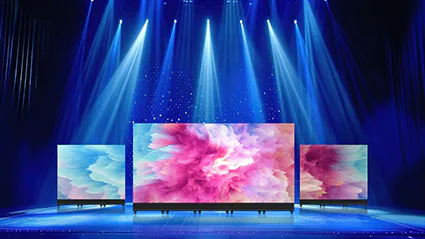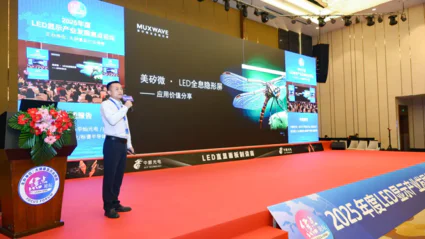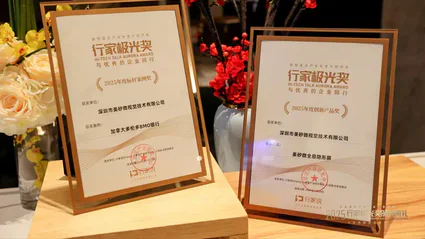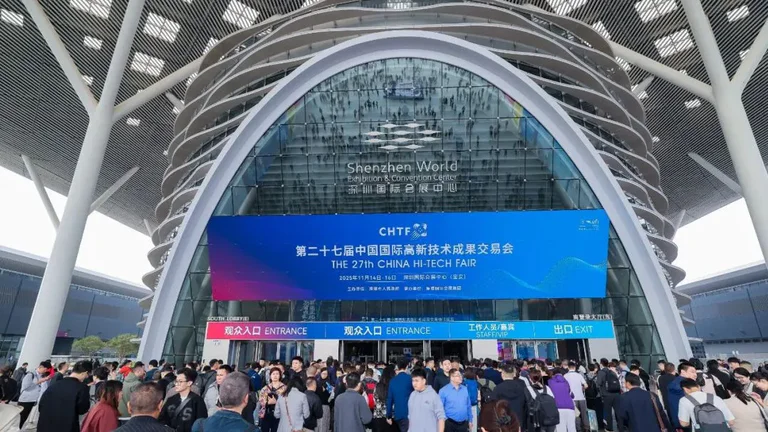주요 내용
- P2.5는 2.5mm 픽셀 피치를 의미하며, 2.5-6m의 실내 시청 거리(매장, 로비, 회의실)에 적합합니다.
- P2.5의 300×525mm 캐비닛은 패널당 120×210픽셀을 제공하며, 일반적인 500×500 LED 패널 P2.5는 200×200픽셀을 제공합니다. 측면, 서비스 전략, 무게, 유지보수 모델에 따라 선택하세요.
- 2.5mm LED 벽면의 경우 3840Hz 이상의 주사율, 진정한 16비트 그레이스케일, 균일성, 저전력 설계에 중점을 둡니다.
- 실제 이미지 품질과 가동 시간을 좌우하는 픽셀 매트릭스, LED/IC, 전력 및 기계적 허용 오차에 대한 p2.5 LED 모듈 사양을 확인하세요.
P2.5 LED 패널이란?
P2.5 LED 패널은 LED 픽셀을 2.5mm 간격으로 배치하여 실내용 P2.5 LED 디스플레이 시나리오에서 높은 디테일을 구현합니다. P3.9 또는 P4/P5에 비해 P2.5는 텍스트, UI 및 제품 샷을 더 미세한 가장자리와 사실적인 피부 톤으로 렌더링하므로 소매점 및 기업 공간의 p2.5 실내 LED 스크린 사이니지에 특히 유용합니다.
P2.5 선택 시기
- 청중은 화면에서 2~8m 떨어져 있습니다(매장 창문, 리셉션, 회의실).
- 필요 사항 높은 픽셀 밀도 비용이 많이 드는 초미세 피치(P1.x)로 이동하지 않고도 사용할 수 있습니다.
- 유연한 캐비닛 크기를 원하는 경우(예, 300×525 또는 500×500)를 사용하여 좁은 벽 치수에 맞출 수 있습니다.
대안을 고려해야 하는 경우
- 2m 이상 근접 → P1.2-P1.8을 확인하세요.
- 8-10m 이상 → P3.X 또는 P4/P5가 더 비용 효율적일 수 있습니다.
캐비닛 크기: 300×525 vs 500×500
캐비닛 (패널이라고도 함)은 하나 이상의 모듈을 고정하는 기계식 프레임을 말합니다. P2.5에서 가장 많이 요청되는 두 가지 캐비닛 풋프린트는 300×525mm와 500×500mm입니다. 둘 다 LED 스크린 P2.5 또는 LED 월 P2.5를 만들 수 있지만 작동 방식은 다릅니다.
캐비닛당 픽셀 계산
- 300×525 LED 패널 p2.5 → 300/2.5 = 폭 120픽셀, 525/2.5 = 높이 210픽셀 → 패널당 120×210픽셀.
- 500×500 LED 패널 p2.5 → 500/2.5 = 폭 200픽셀, 패널당 높이 200픽셀 → 200×200픽셀.
이것이 의미하는 바
- 300×525는 직사각형(세로형)으로 까다로운 벽의 종횡비를 미세 조정하는 데 도움이 됩니다.
- 500×500은 정사각형의 그리드 스타일 빌드를 가속화하고 예비품을 간소화합니다.
기계 및 서비스 고려 사항
- 무게 및 취급: 더 작은 패널(300×525)은 더 가볍고 좁은 실내에서 단일 기술자가 서비스하기 쉬운 경우가 많습니다.
- 곡선 및 홈: 300×525 풋프린트는 완만한 곡선이나 엇갈린 기둥을 더욱 깔끔하게 추적할 수 있습니다.
- 세분화된 높이 단계: 210픽셀 단위(525mm 높이당)는 높은 세로형 벽의 콘텐츠 기준선에 더 잘 맞을 수 있습니다.
- 대여/스테이징: 500×500 캐비닛은 렌탈(빠른 잠금 시스템, 정사각형 스페어)에 탁월하지만 많은 통합업체가 아키텍처에 따라 크기를 혼합합니다.
해결 계획 예시
- 세로 300×525 패널(패널당 120×210픽셀)이 있는 3.6m(W) × 2.1m(H) 벽면: 가로 12개 × 세로 4개 패널 → 1440×840픽셀(≈ 16:9).
- 500×500 팬이 있는 4m × 2m 벽: 8×4 → 1600×800픽셀(2:1).
- 300×525를 사용한 상점 기둥 랩: 4면, 각 폭 525mm × 높이 2.1m → 1면당 1×4 패널 → 1면당 120×840픽셀.
모듈에서 벽까지
빌딩 블록 이해
각 캐비닛에는 LED 모듈이 포함되어 있습니다. P2.5의 경우 가장 일반적인 모듈 매트릭스는 160×160mm(64×64픽셀) 및 320×160mm(128×64픽셀)입니다. 일부 사용자 지정 300×175 또는 210×280 형식도 존재하므로 도면을 잠그기 전에 항상 P2.5 LED 모듈 사양을 확인하세요.
표시되는 주요 용어
- P2.5 LED 모듈 LED와 드라이버 IC가 있는 교체 가능한 타일입니다.
- P2.5 LED 모듈 사양: 픽셀 매트릭스, LED 유형(예: SMD1515 또는 2020), 드라이버 IC 브랜드, 스캔 비율(예: 1/32), 밝기, 그레이스케일, 전원 및 커넥터 위치.
- P2.5 RGB LED 패널: 픽셀당 풀컬러 RGB 작동을 강조하기 위해 사용되기도 합니다.
모듈 사양이 중요한 이유
- 드라이버 IC 는 낮은 밝기에서의 그레이스케일 안정성과 고스트 방지 기능을 결정합니다.
- LED 패키지 는 색상 균일성 및 축을 벗어난 색상 변화에 영향을 줍니다.
- 스캔 비율 및 새로 고침 카메라 친화성 및 깜박임 방지 기능을 설정합니다.
- 평탄도 허용 오차 는 이음새 가시성에 영향을 줍니다.
최종 P2.5 모듈 사양
아래는 RFP에 적용할 수 있는 참조 사양입니다. 이를 사용하여 모든 LED P25 실내 제품군을 평가하세요.
광학
- 픽셀 피치: 2.5mm
- 픽셀 구성: 1R1G1B SMD(예: 1515/2020)
- 밝기(일반): 800-1200cd/m² 실내
- 색심도: 14-16비트
- 재생률: 3840Hz 이상(카메라가 많은 장소에서는 더 높게 설정)
- 화이트 포인트: D65(브랜드에 따라 조정 가능)
전기
- 최대 전력(모듈): ≈ 30-45W(캐비닛 총합은 다양함)
- 평균 전력: ≈ 콘텐츠에 따라 최대 1/3
- 스캔: 1/32 / 1/16(매트릭스별 확인)
- 전압: 5VDC(통상)
기계
- 모듈 크기: 320×160㎜(또는 160×160㎜), 두께 ≤ 12㎜
- 평탄도 허용 오차: ≤ 0.2mm
- 전면/후면 서비스: 자석 + 퀵 릴리스(옵션)
- 커넥터: 정렬 포스트가 있는 골드 핑거/데이터 리본
신뢰성
- 균일성 보정: 공장 + 현장 미세 조정
- 데드 픽셀 사양: ≤ 1/10,000; 균일성 델타-E 목표 제공
- 인증: CE / RoHS; 북미 프로젝트용 ETL/UL
전문가 팁: 구매 주문서에 p2.5 LED 모듈 사양 사본을 첨부하여 배치 전체에 걸쳐 균일성과 구성 요소를 보호하세요.
고품질 P2.5 실내 LED 스크린을 위한 성능 기둥
2.5 LED 스크린이든 실내용 2.5 LED 디스플레이이든 동일한 네 가지 기둥이 성공을 결정합니다.
가독성 및 색상
- 타겟 D65 흰색과 안정적인 로우 레벨 그레이스케일을 사용하여 저녁 밝기를 낮춰도 브랜드 색상이 유지됩니다.
- 2.5인치 실내 LED 화면에서는 미묘한 가장자리가 후광을 더 많이 받습니다.
카메라 친화성
- 3840Hz 이상의 새로고침과 콘텐츠 프레임 속도에 맞춘 스캔 매핑으로 휴대폰과 방송 카메라의 깜박임을 줄입니다.
균일성 및 이음새
- 인도 시 심 맵을 요청하세요. 미세한 간격은 그라디언트에서 눈에 띄는 수직을 유발하므로 모듈 평탄도와 심이 중요합니다.
음향적 편안함 및 파워
- 로비와 매장에는 저소음 전원(가능한 경우 팬이 없는)을 지정하세요.
- 콘텐츠 디밍 + 일광 감지 기능을 사용하여 대비를 유지하면서 20-40%의 전원을 차단합니다.
실제로 필요한 2.5mm LED 벽 디자인하기
시야 거리 → 픽셀 피치
경험 법칙: 피치 ≈ 최소 편안한 거리(m). 2.5mm의 경우, 많은 시청자가 2.5~3m 이상에서 편안함을 느낍니다. 청중이 2m보다 가까이 서 있는 경우 P1.8/P1.5로 낮추는 것을 고려하세요.
화면비 및 콘텐츠
- 기업 및 DOOH, 16:9 를 사용하는 것이 미디어 재사용에 가장 쉽습니다.
- 소매용 세로 리본(예: 720×1920픽셀)은 300×525 브릭(210픽셀 높이 단위)으로 자연스럽습니다.
- 안전한 텍스트 크기 유지: 3~5m에서는 60~80픽셀 이상의 본문 사본, 6~10m에서는 90~120픽셀 이상을 목표로 합니다.
밝기 계획
- 주간 인테리어는 일반적으로 600-1000cd/m²; 높은 유약 아트리움은 다음을 원할 수 있습니다. 1200+ cd/m².
- 사용 자동 디밍 캡과 스무딩을 사용하여 구름으로 “호흡”하는 것을 방지합니다.
콘텐츠에서 해야 할 일과 하지 말아야 할 일
- 대담하고 대비가 높은 구도를 선호합니다.
- 밝고 섬세한 배경에 얇은 흰색 텍스트는 피하세요.
- 클램프 피크 흰색을 85-90% 를 사용하여 눈부심을 억제합니다.
작업 예제
예시 A - 기업 로비, 4.8m × 2.625m
- 캐비닛: 300×525, 세로 방향
- 레이아웃: 가로 16 × 세로 5 → 1920×1050픽셀
- 사용프레젠테이션, 브랜드 모션 루프
- 참고: 16:9 비율; 가벼운 레터박싱으로 1080p 콘텐츠를 쉽게 리포팅할 수 있습니다.
예제 B - 리테일 윈도우 리본, 2.4m × 3.15m 세로형
- 캐비닛: 300×525
- 레이아웃폭 8 × 높이 6 → 960×1260 픽셀
- 사용캠페인 포스터, QR코드
- 참고키가 큰 레이아웃으로 시야를 가리는 것을 방지합니다. P2.5 LED 포스터 스타일 콘텐츠.
예제 C - 세미나 무대, 5m × 3m, 빠른 구축
- 캐비닛: 500×500
- 레이아웃: 10×6 → 2000×1200픽셀
- 사용슬라이드 + 기조연설 동영상
- 참고정사각형 벽돌 스피드 리깅; LED 2.5 타일을 사용하는 렌탈 키트에 이상적입니다.
설치 및 통합
마운팅
- 미세 조정 마운트가 있는 고정 프레임 또는 건식 벽체 백킹용 다이렉트 투 스터드 레일.
- 전면 서비스 자석 또는 후면 접근을 위한 서비스 간격을 유지하세요.
전기 및 제어
- 차단기 라벨을 사용하여 열마다 AC 피드를 분배하고 부하를 분산합니다.
- 평판이 좋은 발신자/수신자 체인 사용, 원격 관리를 위한 IP 제어.
- p2.5 주도 포스터 배포의 경우 올인원 플레이어가 CMS 워크플로우를 간소화합니다.
열 및 먼지
- 깨끗한 흡입 경로를 확보하고 필요한 경우 필터 청소 일정을 예약하세요.
- 고르지 않은 노화를 유발하는 직접적인 HVAC 폭발을 피하세요.
시운전 체크리스트
- 기본 발신자에 대한 균일성 맵, 화이트포인트 설정, 새로고침/프레임 테스트, 디밍 곡선 검증, 장애 복구 드릴을 제공합니다.
유지 관리 및 SLA
- 2-5%의 모듈 예비 재고와 벽당 최소 하나의 예비 캐비닛 및 수신기를 보관하세요.
- 분기별 상태 점검: 데드 픽셀 스캔, 솔기 조임, 먼지 제거.
- 조명이 가변적이거나 런타임이 많은 공간의 경우 매년 재보정합니다.
가격 요소 및 TCO
1.LED 패키지 및 IC 브랜드, 새로고침 등급 및 보정 파이프라인을 확인할 수 있습니다.
2.캐비닛 재질 (다이캐스트 대 스틸), 서비스 방법, 무게 등을 고려합니다.
3.컨트롤러/CMS 라이선스 및 모니터링.
4.에너지 (평균 W/m² × 시간 × $/kWh) 및 HVAC 영향.
5.설치 복잡성 (구조, 리프트, 허가).
6.보증 및 SLA (현장 교체 시간, 원격 지원).
자주 묻는 질문
Q1: P2 5 LED 패널과 P2.5 LED 패널의 차이점은 무엇인가요?
없음 - 일부 카탈로그는 LED P2 5, 다른 카탈로그는 P2.5로 표기합니다. 둘 다 2.5mm 픽셀 피치를 의미합니다.
Q2: 300×525 LED 패널 p2.5가 500×500 LED 패널 p2.5보다 낫나요?
두 가지 모두 보편적으로 더 나은 것은 아닙니다. 300×525는 더 세밀한 종횡비 단계와 세로 유연성을 제공하며, 500×500은 정사각형 그리드 빌드 및 렌탈 스페어 속도를 높입니다.
Q3: 곡선형 로비에 실내용 P2 5 LED 디스플레이를 구축할 수 있나요?
예 - 좁은 캐비닛(300×525) 및 세그먼트 프레임 사용, p2.5 LED 모듈 사양으로 최소 반경을 확인합니다.
Q4: 300×525의 6×4 캐비닛에서 어떤 해상도를 얻을 수 있나요?
6×4 패널 → (6×120) × (4×210) = 720×840픽셀.
Q5: P2 5 RGB LED 패널 월을 위한 전용 컨트롤러가 필요한가요?
총 픽셀 수, 3840Hz 이상의 새로 고침 빈도, CMS 코덱 파이프라인을 지원하는 메인스트림 발신자/수신자 체인을 사용하세요.
Q6: p2.5 LED 포스터는 어디에 적합합니까?
플러그 앤 플레이, 실내용 2.5 LED 디스플레이 성능, 빠른 콘텐츠 교체 등 소매점 창구 및 팝업에 이상적입니다.
Q7: 밝은 아트리움에서 LED 스크린 p2.5의 밝기는 어떻게 되나요?
자동 디밍 및 고대비 아트웍으로 주간 1000-1200cd/m²를 목표로 합니다.
주문 방법
- 멀리언, 깊이, 서비스 액세스 권한이 있는 건축 도면을 공유하세요.
- 선택 측면 및 설치 제약 조건에 따라 캐비닛 크기(Muxwave는 300×525만 제공)를 제한합니다.
- p2.5 LED 모듈 사양을 확인합니다: LED 패키지, 드라이버 IC, 스캔, 밝기.
- 컨트롤러 브랜드와 CMS 흐름을 잠그고 콘텐츠 팀을 위해 픽셀 맵을 조기에 요청하세요.
- 심 맵, 화이트 포인트, 새로고침 테스트, 노이즈 제한 등 QA 및 승인 정의.
- 유지보수 및 예비품 계획을 세우고 분기별 상태 점검 일정을 잡으세요.
결론
잘 사양된 300×525 LED 패널 p2.5 시스템은 정사각형 벽돌로는 따라갈 수 없는 캐비닛 유연성을 갖춘 프리미엄 실내 비주얼을 제공합니다. 컴팩트한 로비 기능을 구축하든, 높은 리테일 리본을 구축하든, p2.5 LED 모듈과 캐비닛 수학을 이해하고 500×500 LED 패널 p2.5와의 장단점을 파악하면 브랜드에 실제로 필요한 선명하고 편안하며 카메라 친화적이고 서비스가 쉬운 2.5mm LED 월을 만들 수 있습니다.
추천 읽기
1. 투명 LED 디스플레이와 기존 LED 스크린 비교
2.투명 LED 디스플레이가 매장을 혁신하는 방법
3.무역 박람회 및 전시회를 위한 최고의 커브드 LED 디스플레이 10가지



